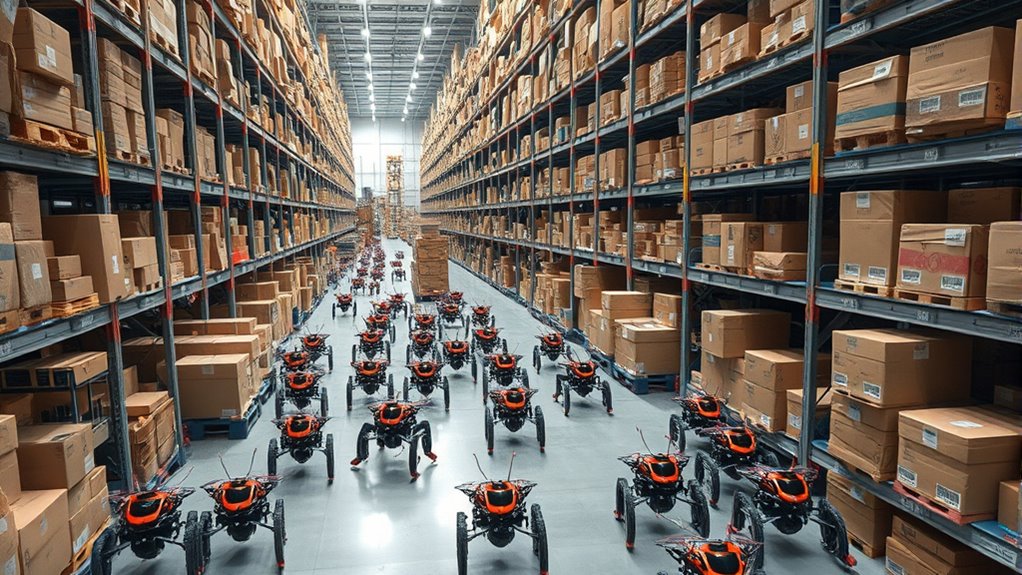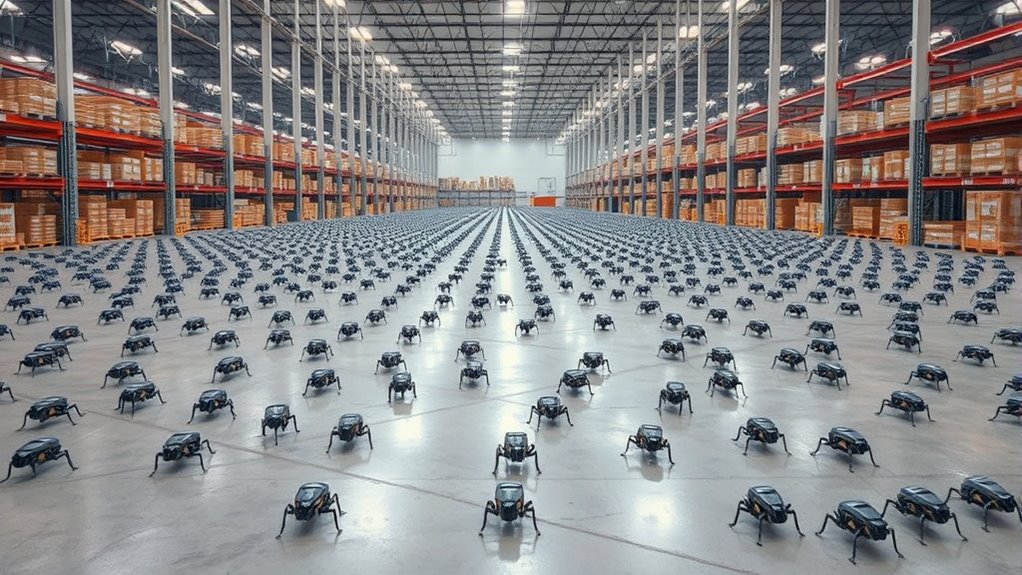Imagine a swarm of tiny robots working seamlessly together in a busy warehouse, each one following simple rules yet achieving complex tasks. This approach, inspired by ant colonies, allows these machines to adapt quickly to obstacles and changing demands without central control. As you explore how these principles translate into real-world logistics, you’ll discover why swarm robotics could reshape the future of inventory management and transportation. What makes this collective behavior so powerful?
Key Takeaways
- Swarm robotics mimics ant colonies’ decentralized coordination using simple rules and local interactions.
- Collective behaviors emerge from individual robots’ actions, enabling flexible and adaptive warehouse operations.
- Local communication allows robots to share information, optimize tasks, and re-route around obstacles seamlessly.
- The system’s resilience ensures continued operation despite robot failures, with easy scalability by adding more units.
- Nature-inspired principles promote secure, efficient, and robust warehouse management through simple autonomous agents.

Have you ever wondered how a group of simple robots can work together to accomplish complex tasks? It’s a fascinating concept rooted in the principles of swarm robotics, where numerous inexpensive, autonomous robots collaborate seamlessly. This approach draws heavily from nature, particularly from ant colonies, which demonstrate incredible efficiency through simple rules and local interactions. At the core of this system is robot coordination, where each robot follows basic behaviors that, when combined, lead to sophisticated, collective outcomes. This coordination isn’t dictated by a central controller but emerges naturally from the interactions among robots, giving rise to what’s known as emergent behavior. These behaviors are unpredictable in detail but highly effective, enabling the swarm to adapt to changing environments and tasks without explicit programming for every scenario.
In warehouse settings, applying swarm robotics involves deploying many small robots that work together to manage inventory, transport goods, and optimize space. Instead of relying on a few highly specialized machines, you have a fleet of simple units following straightforward rules. For example, each robot might be programmed to pick up items, avoid obstacles, and communicate with neighboring units. When one robot finds an item or an open path, it shares that information with nearby robots, who then adjust their actions accordingly. This local communication and decision-making lead to a coordinated effort that maximizes efficiency without the need for constant human oversight. The emergent behavior here ensures that the entire system can adapt dynamically to new tasks, blockages, or changes in demand, much like an ant colony reroutes foraging paths when obstacles appear.
What makes this approach so powerful is that the complexity arises from the simple rules governing individual robots. No single robot needs to understand the entire warehouse layout or the full scope of the operation. Instead, they rely on local interactions to produce a global order. This decentralized system is resilient; if one robot fails, others can quickly adapt, re-routing themselves or taking over tasks. It also scales easily—adding more robots enhances capacity without significant reprogramming. The key lesson from ant colonies is that simple agents, following straightforward rules, can generate highly sophisticated and adaptable behaviors through their interactions. When applied to warehouses, this principle results in more flexible, efficient, and robust operations, demonstrating the incredible potential of swarm robotics inspired by nature’s own problem solvers. Additionally, leveraging AI security technologies can help protect these autonomous systems from cyber threats and ensure safe operation in sensitive environments.
Conclusion
Just like an ant colony seamlessly works together to build and forage, swarm robotics in warehouses show how simple robots can coordinate to create efficient, resilient systems. By mimicking nature’s collective intelligence, you can develop adaptable solutions that handle obstacles and changing demands with ease. Embracing this approach is like watching a flock of birds turn and glide in perfect harmony—you’ll see how small actions, when combined, lead to remarkable results.









